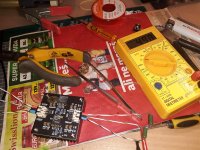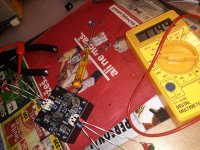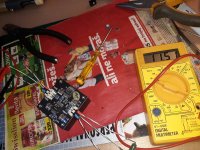I have some other LT1963+LT3015 regulators with identical components on both LDO. And everything works as it should. In the datasheet, they write only the maximum recommended values, I see no reason for different values on the plus and minus regulators. That's why I ask.
Strange as the datasheets clearly show different values for same voltage output for the two regs. Now this is also a difference ratio between the resistors ? And the programmable Lt19xx and LT30xx are also different than the standalone voltage output ones ?
No, the resistor ratio must be the same. It can be seen from the formula of the output voltage. The only difference is that the current on the Adj pin is lower with the LT3015 than with the LT1963, but if the resistor values are small this is negligible. And you have a trimmer for fine tuning.Now this is also a difference ratio between the resistors ?
I used fixed resistors that I had. I achieved +-4.98V, +11.44V and -11.51V. I can adjust more accurately, but I don't care if it's 12V or 11.44V/11.51V on the Sparkos.
Last edited:
I doubt there is any difference in performance, just that they are fixed output voltage. And therefore simpler to use.And the programmable Lt19xx and LT30xx are also different than the standalone voltage output ones ?
Yes you can use the same "ratio" values for both sides. I only followed datasheet for the quiescent current, but it seems be not very important for the performance of these regulators 😉On the PSU2, resistor and trimmer values are not the same with LT1963 and LT3015. Can I use the same values for the plus and minus sides, with all values as for the LT1963?
Thanks Miro, that's what I thought. So all values of resistors, trimmers and capacitors could be as for LT1963. I do not recommend the other way around.
Last edited:
Very nice project. Was looking for something like this. Looks perfect. But the gerbers on #1 are they the latest? There seems to be more versions during this topic. Idem question for the PSU1.
Yes. I have no idea why datasheet specified different quiescent currents 😀Thanks Miro, that's what I thought. So all values of resistors, trimmers and capacitors could be as for LT1963. I do not recommend the other way around.
#2180 this is nice 🙂Very nice project. Was looking for something like this. Looks perfect. But the gerbers on #1 are they the latest? There seems to be more versions during this topic. Idem question for the PSU1.
Yes. I have no idea why datasheet specified different quiescent currents 😀
Probably because they are really different. 🤣
Datasheet is datasheet, you didn't make these DACs exactly according to the datasheet, but it still turned out well beyond all expectations.

In principle, in those places, smaller resistors are always placed on that voltage divider than is prescribed as max. value in the datasheet. Some put larger resistors abusing the safety margin left by the manufacturer for the voltage regulator to work properly.
I'm not al that at home at the data transfer. But can i use my Ian Canada Fifipi fot the I2s or is there some extra board/converting required?
@Arnolddew What is your source device for audio transfer? Is that USB, optical, bluetooth, lan or sd-card?
RPI is connected through LAN or USB? .... Best if you buy some USB-I2S device and connect it directly to USB in your Mac Mini. You can also connect this USB-I2S directly over raspberry usb #1373 😉
You can start with the cheapest USB-I2S device ... the sound will be very good: https://www.aliexpress.com/item/4000166755098.html
You can start with the cheapest USB-I2S device ... the sound will be very good: https://www.aliexpress.com/item/4000166755098.html
PCM63P DAC plays even better now. The bass is even stronger now than it was then. The middle tones are even more natural and lively. This DAC must be allowed to play for at least a month. Nothing should be touched for at least a month. Then it shows the maximum.👍AD1865 vs PCM63- my view
Bass area better AD1865.
Mid and high Better PCM63.
The differences are not big, but they are audible.
Bass ... AD1865 has more of it, more present, tighter, more precise. PCM63 has it, but after AD, something is missing.
Mids and highs ... somehow more natural and realistic, voices and instruments got something that AD doesn't have. Salted it with magic dust. The cymbal on the Jakob Bo - Gefion got something I can't describe. There was another song where I heard some other sounds that I didn't hear and then returned it. Now, as good as it is, it doesn't work for a bad production. It is more noticeable with PCM63 when something is not OK.
Stage ... no complaints, I'd just have to listen to it and compare. I honestly have no idea.
Conclusion ... if I hadn't heard the PCM63 and compared it directly with the AD1865 I would think it is the same. Well, I heard it. Since I have boards, chips, and I'm missing a few capassitors, resistors ... I'll make it.
miro1360, thanks again for the excellent dacs
So like wine, maybe in 10 years it will be even better, and maybe during that time you will learn to make a good tube output.🤣🤣
I hope that after this I will be in the ignore list because it is a sin to mention the tube here.🤣🤣
I hope that after this I will be in the ignore list because it is a sin to mention the tube here.🤣🤣
No No Grunf, don’t stop tube talk!! I’m currently working on a 6n6p output stage and experimenting with an SMPS for HV/Filament power.
There is more than one way to skin a cat as they say, tubes are just another flavor 🙂
There is more than one way to skin a cat as they say, tubes are just another flavor 🙂
- Home
- Source & Line
- Digital Line Level
- DAC AD1862: Almost THT, I2S input, NOS, R-2R


